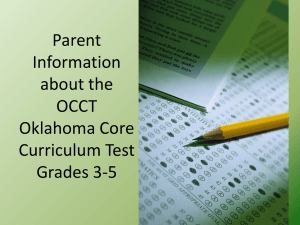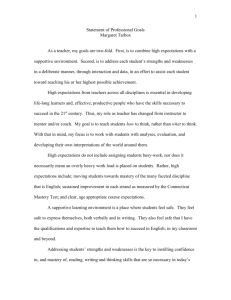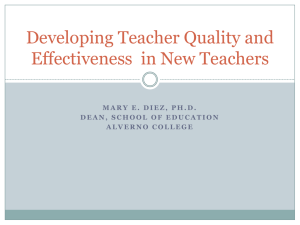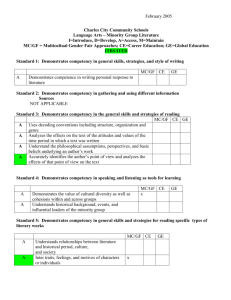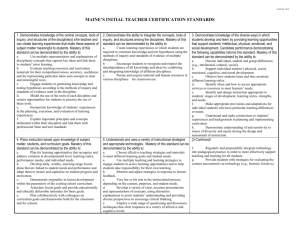MSU BILLINGS COLLEGE OF EDUCATION EVIDENCE OF
advertisement
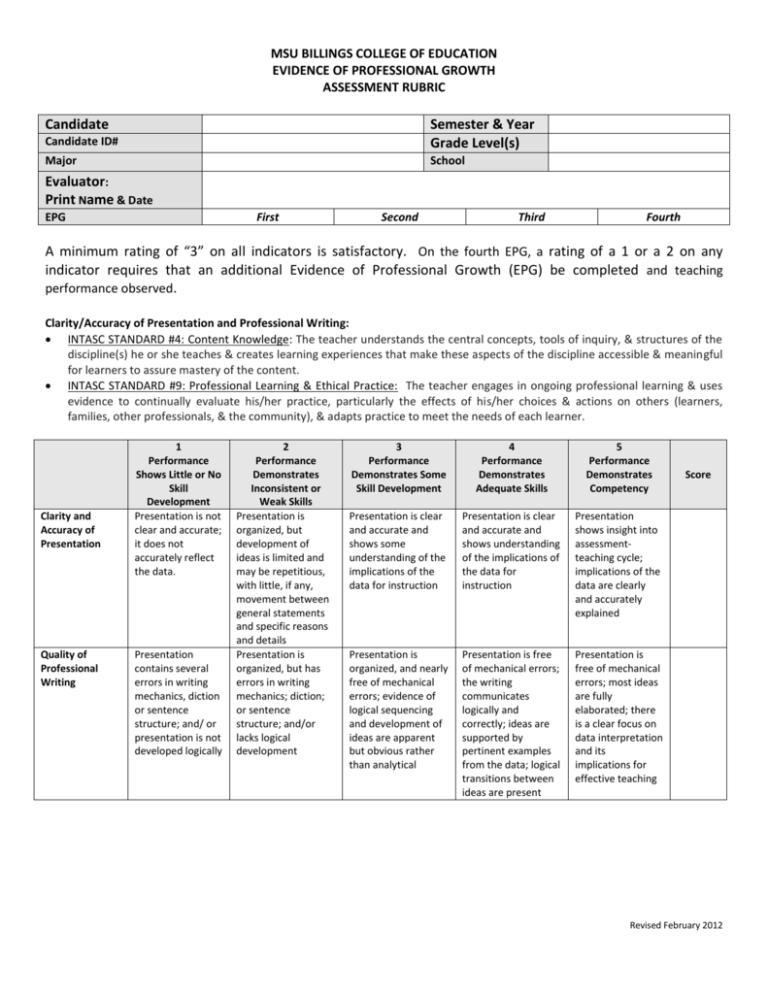
MSU BILLINGS COLLEGE OF EDUCATION EVIDENCE OF PROFESSIONAL GROWTH ASSESSMENT RUBRIC Candidate Candidate ID# Semester & Year Grade Level(s) Major School Evaluator: Print Name & Date EPG First Second Third Fourth A minimum rating of “3” on all indicators is satisfactory. On the fourth EPG, a rating of a 1 or a 2 on any indicator requires that an additional Evidence of Professional Growth (EPG) be completed and teaching performance observed. Clarity/Accuracy of Presentation and Professional Writing: INTASC STANDARD #4: Content Knowledge: The teacher understands the central concepts, tools of inquiry, & structures of the discipline(s) he or she teaches & creates learning experiences that make these aspects of the discipline accessible & meaningful for learners to assure mastery of the content. INTASC STANDARD #9: Professional Learning & Ethical Practice: The teacher engages in ongoing professional learning & uses evidence to continually evaluate his/her practice, particularly the effects of his/her choices & actions on others (learners, families, other professionals, & the community), & adapts practice to meet the needs of each learner. Clarity and Accuracy of Presentation Quality of Professional Writing 1 Performance Shows Little or No Skill Development Presentation is not clear and accurate; it does not accurately reflect the data. Presentation contains several errors in writing mechanics, diction or sentence structure; and/ or presentation is not developed logically 2 Performance Demonstrates Inconsistent or Weak Skills Presentation is organized, but development of ideas is limited and may be repetitious, with little, if any, movement between general statements and specific reasons and details Presentation is organized, but has errors in writing mechanics; diction; or sentence structure; and/or lacks logical development 3 Performance Demonstrates Some Skill Development 4 Performance Demonstrates Adequate Skills 5 Performance Demonstrates Competency Presentation is clear and accurate and shows some understanding of the implications of the data for instruction Presentation is clear and accurate and shows understanding of the implications of the data for instruction Presentation shows insight into assessmentteaching cycle; implications of the data are clearly and accurately explained Presentation is organized, and nearly free of mechanical errors; evidence of logical sequencing and development of ideas are apparent but obvious rather than analytical Presentation is free of mechanical errors; the writing communicates logically and correctly; ideas are supported by pertinent examples from the data; logical transitions between ideas are present Presentation is free of mechanical errors; most ideas are fully elaborated; there is a clear focus on data interpretation and its implications for effective teaching Score Revised February 2012 Analysis of Student Learning: INTASC Standard #5: Application of Content: The teacher understands how to connect concepts & use differing perspectives to engage learners in critical thinking, creativity, & collaborative problem solving related to authentic local & global issues. INTASC Standard #6: Assessment: The teacher understands & uses multiple methods of assessment to engage learners in their own growth, to monitor learner progress, & to guide the teacher’s & learner’s decision making. INTASC Standard #8: Instructional Strategies: The teacher understands & uses a variety of instructional strategies to encourage learners to develop deep understanding of content areas & their connections, & to build skills to apply knowledge in meaningful ways. 1 Performance Shows Little or No Skill Development Learning Objectives Identified Fails to provide a clear learning objective, and/or fails to indicate expectations for mastery Assessment System Includes Baseline, Formative and Summative Assessments Does not show evidence of a comprehensive assessment plan, including baseline, formative, and summative assessments Data Is Collected Systematically 2 Performance Demonstrates Inconsistent or Weak Skills Provides a learning objective but the objective is either not aligned to curriculum standards, not measurable, or does not clearly indicate expectations for mastery 3 Performance Demonstrates Some Skill Development 4 Performance Demonstrates Adequate Skills Provides a learning objective and shows connection either to standards/curriculum or to expectations for mastery Provides a measurable learning objective that is aligned to appropriate standards and/or curriculum scope and sequence; indicates expectations for mastery Has an assessment plan, but in some way the plan is not fully described or developed; aspects of a complete system are missing or not implemented Has a complete assessment plan and implements some, but not all components of the plan Develops and utilizes a complete assessment plan, including baseline, formative and summative components Fails to collect data OR collects data, but does not do so in a meaningful or systematic way Collects some, but not all types of basic data for analyzing learning Collects meaningful data, including baseline, formative and assessment data Lesson Activities Align with Learning Objectives Fails to align learning activities to learning objectives Aligns some, but not all learning activities to the learning objective Collects data related to the assessment plan, but data are not collected on all aspects of the plan or some of the data collected is not meaningful Makes partial connections with learning objectives, but fails to provide a comprehensive profile of student learning relative to the whole class, subgroups, OR individual students Interpretation of Data Fails to analyze or interpret data accurately Interprets data but has some difficulty drawing reasonable conclusions or determining how to use the data for decision-making Interprets data in a technically accurate way, but conclusions are missing or not fully supported by data Interprets data meaningfully and draws appropriate conclusions based on the data Evidence of Impact on Student Learning Fails to show credible evidence of student progress toward mastery of the learning objectives Analyzes student learning, but includes incomplete evidence of impact on student learning; provides limited evidence of student progress Analyzes student learning and provides some credible evidence of impact on student learning OR provides some evidence of student progress Analyzes student learning by showing evidence of the impact on student learning in terms of individual progress toward mastery of the learning Makes connections between learning objectives and learning activities; provides a profile of student learning for the whole class, subgroups, AND individual students 5 Performance Demonstrates Competency Score Provides a clearly written, measurable learning objective; shows how the learning objective relates both to standards and to curriculum; indicates expectations for mastery and provides a rationale for these expectations Develops and implements a complete assessment plan designed to assess the level of mastery of the learning objective by the students receiving instruction Collects data in a well organized, systematic manner and uses data to adjust instruction Makes connections between learning objectives and learning activities; provides a comprehensive profile of student learning for the whole class, subgroups, AND individual students Interprets data meaningfully, draws conclusions based on the data, and uses data to make appropriate instructional decisions Analyzes student learning and clearly communicates student learning in terms of individual progress toward mastery of the Revised February 2012 toward mastery of learning objectives toward mastery of learning objectives objectives learning objectives Reflection and Self-Evaluation: INTASC STANDARD #1: Learner Development: The teacher understands how learners grow & develop, recognizing that patterns of learning & development vary individually within & across the cognitive, linguistic, social, emotional, & physical areas, & designs & implements developmentally appropriate & challenging learning experiences. INTASC STANDARD #2: Learning Differences: The teacher uses understanding of individual differences & diverse cultures & communities to ensure inclusive learning environments that enable each learner to meet high standards. INTASC STANDARD #3: Learning Environments: The teacher works with others to create environments that support individual & collaborative learning, & that encourage positive social interaction, active engagement in learning, & self-motivation. INTASC STANDARD #7: Planning for Instruction: The teacher plans instruction that supports every student in meeting rigorous learning goals by drawing upon knowledge of content areas, curriculum, cross-disciplinary skills, & pedagogy, as well as knowledge of learners & the community context. INTASC STANDARD #9: Professional Leaning & Ethical Practice: The teacher engages in ongoing professional learning & uses evidence to continually evaluate his/her practice, particularly the effects of his/her choices & actions on others (learners, families, other professionals, & the community), & adapts practice to meet the needs of each learner. 1 Performance Shows Little or No Skill Development Shows little or no evidence of selfreflection when analyzing the impact of instruction on student performance 2 Performance Demonstrates Inconsistent/WeakSkills Provides evidence of self-reflection concerning impact on student learning, but the reflection shows simplistic, superficial reasons or hypotheses to support conclusions drawn 3 Performance Demonstrates Some Skill Development Provides evidence of self-reflection showing some credible conclusions concerning the impact of instruction on student learning; conclusions are at least partially supported by data 4 Performance Demonstrates Adequate Skills Uses evidence to support conclusions drawn concerning the impact of instruction on learning; explores multiple hypotheses for why students did or did not master the learning objective Insights on Effective Instruction Provides no rationale for why some activities were more successful than others in assisting students to master the learning objective Identifies successful or unsuccessful activities, but does so for simplistic reasons Identifies some successful or unsuccessful activities based on the performance of the students; explores some reasons for student progress or lack thereof Insights on Effective Assessment Fails to evaluate the assessments used Evaluates assessment techniques, but makes limited or superficial suggestions for improving these techniques Evaluates assessment techniques and makes suggestions for refinement of techniques for future use Identifies successful and unsuccessful activities based on the performance of the students and provides plausible reasons (based on theory or research) for their progress or lack thereof Analyzes the format of assessments and their effectiveness in yielding useful data for guiding instruction and motivating students Alignment Among Goals, Instruction and Assessment Does not connect learning goals, instruction, and assessment results Connects learning goals, instruction, and assessment results, but misunderstandings or conceptual gaps are present Logically connects learning goals, instruction, and assessment results in drawing some conclusions about student learning and effective instruction Logically connects learning goals, instruction, and assessment results in order to plan more effective instruction Implications for Future Teaching Provides no ideas or inappropriate ideas for redesigning learning goals, instruction, and assessment Provides ideas for redesigning learning goals, instruction, and assessment but offers no rationale for why these changes would improve student learning Provides some ideas for redesigning learning goals, instruction, and assessment and explains why these modifications would improve student learning Redesigns learning goals, instruction based on assessment results; provides credible rationales for databased decisions Interpretation of Student Learning 5 Performance Demonstrates Competency Paints a comprehensive picture of how instruction affected student learning; analyzes in some depth reasons why students did or did not attain mastery of the learning objective Analyzes the value of learning activities and determines, on the basis of impact on student learning, ways to improve learning activities to gain better results in the future Analyzes the impact of assessment results on instruction and student progress; considers ways to involve students in assessment of their own performances Logically connects learning goals, instruction, and assessment results in order to plan more effective instruction; uses assessment results to differentiate instruction to meet individual needs Plans future instruction on the basis of student profiles and assessment of student needs as well as reflection on previous experience Score Revised February 2012 Revised February 2012
